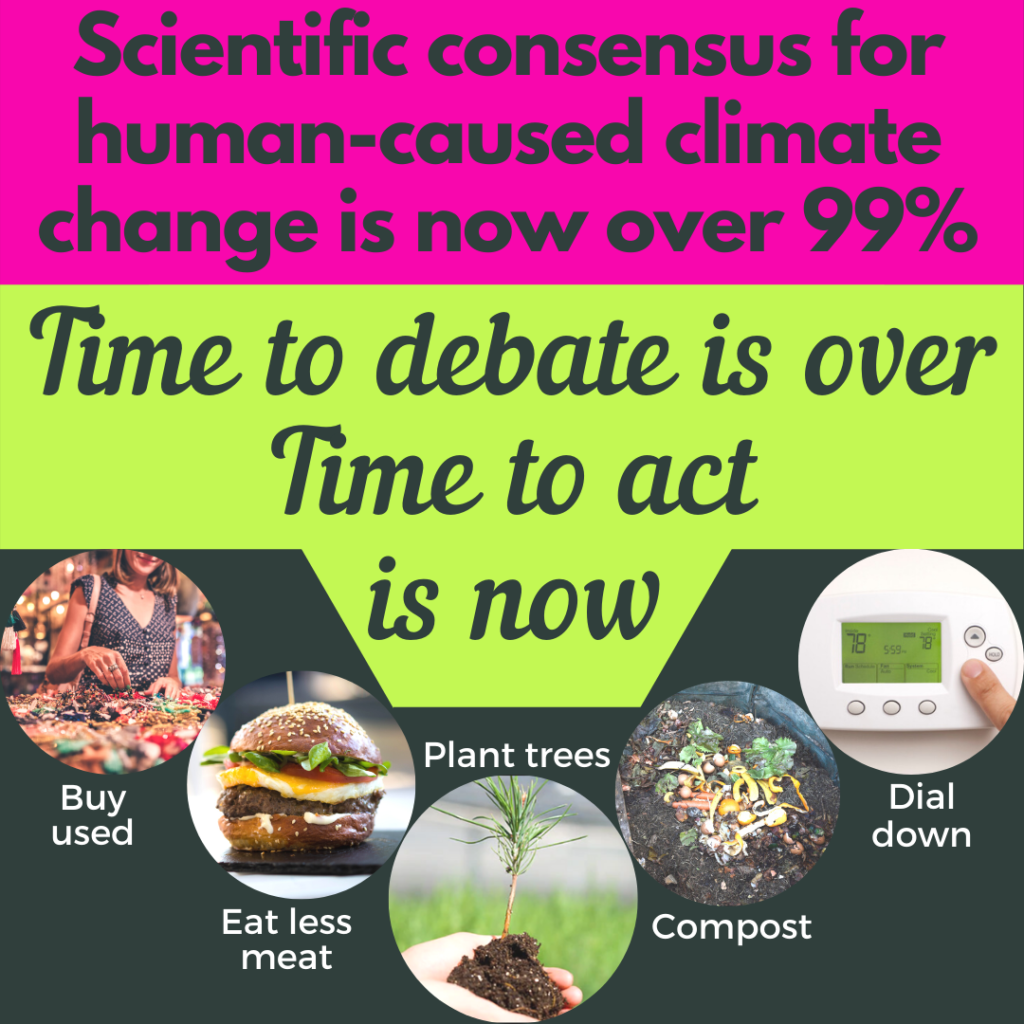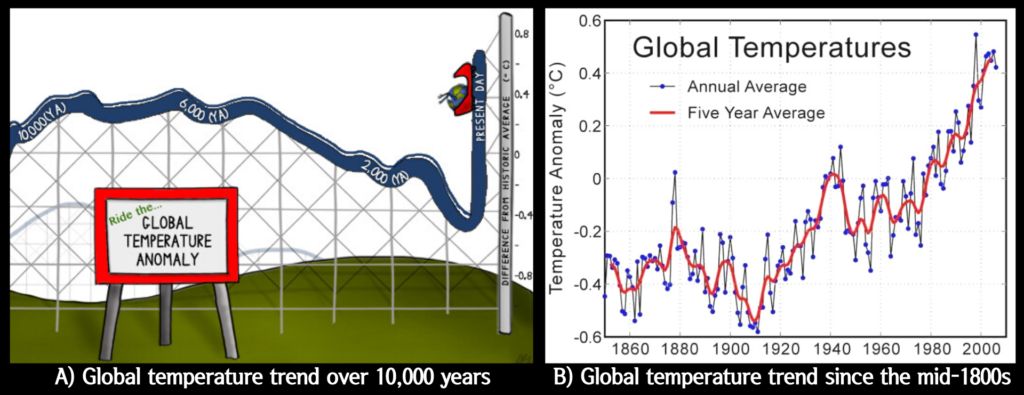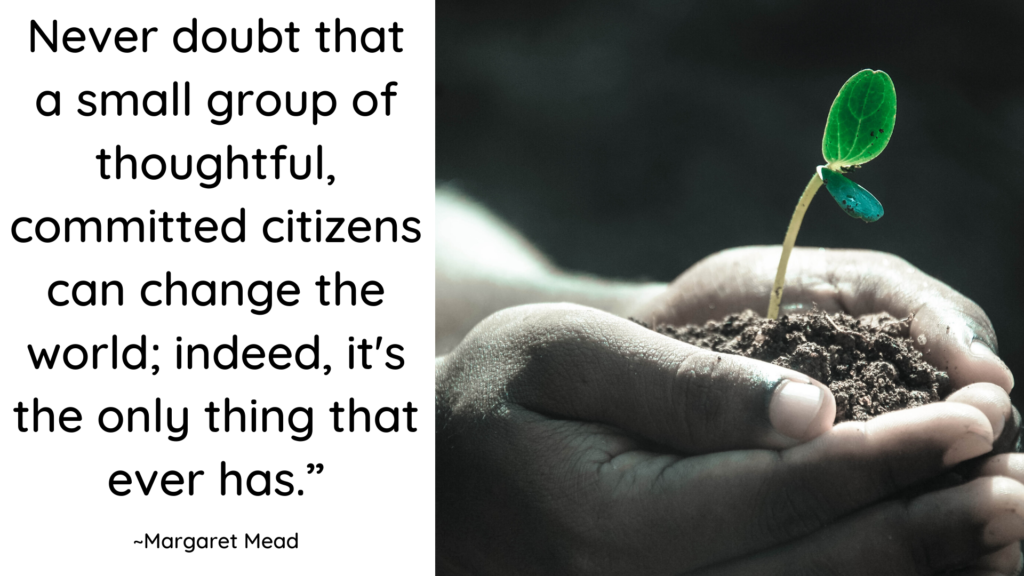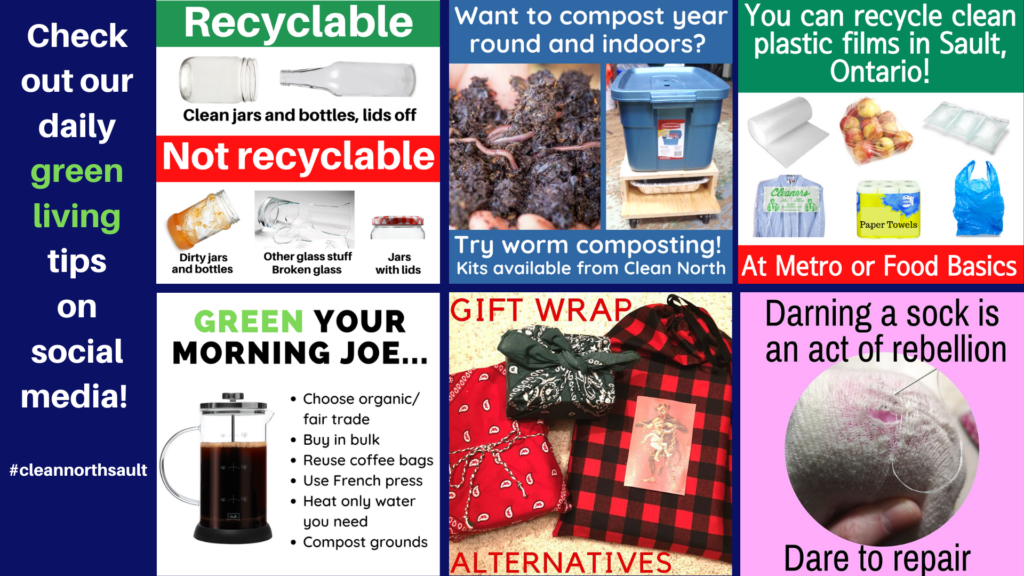The evidence for climate change | what can we do | reduce energy use
shop smart | reduce waste | eat less meat
Climate change is causing major and even devastating changes affecting people, ecosystems, and the economy — and not just in far off places but also right here in northern Ontario.
Each of us can help fight climate change by taking action to help build a more resilient community and sustain quality of life for ourselves, our children and grandchildren — especially through a greener lifestyle (recycling more, buying used, avoiding plastic, etc.; lots of tips farther down this page).

The evidence for climate change
Convinced about climate change? Skip ahead to dive into ways to help now
Need more convincing? Keep reading….
Virtually all scientists studying climate change today agree — based on overwhelming scientific evidence — that it is extremely likely that the climate is changing at a dramatic rate, that humans are causing this change through fossil fuel use and deforestation, and that the effects on people, the economy, and the environment are already being felt (source).
Some climate change facts:

Sources for graphics: Climate.gov, New Scientist
- Historical records show that average temperatures began to rise suddenly around the time of industrialization and that the changes since then are well outside what’s happened typically over the past 10,000 years (source). The change is even more pronounced if you look at 1860 to the present.
- Every year since 1998 has been warmer than the 20th century average. So today’s young adults do not remember a “normal” Canadian climate (source).
- Canada’s climate is changing faster than the rest of the world’s, with the Far North’s climate changing three times as fast (source).
- Extreme weather is becoming more common, with more, larger, and more intense fires; more flooding; and more crop failures and property damage. Since the 1980s, insurance payouts for severe weather damage claims in Canada have doubled every five to 10 years (source).
- As the climate changes, trees and plants are expected to become less and less adapted to the local climate, which could reduce forest health and affect the forest and tourism industries. For example, by the end of this century, the Far North of Ontario could have a climate suitable for growing sugar maple (source), and places where sugar maple is growing today (like St. Joseph Island) may no longer be able to grow this species.
- Lake Superior is warming faster than the other Great Lakes — in fact, it’s one of the fastest-warming lakes in the world (source). This trend could spell disaster for coldwater fish species like lake trout and lake whitefish, affect the fishing industry, and allow more invasive species such as Asian carp to take hold and thrive. In addition, extreme changes in lake levels are affecting lakefront property (in recent years we’ve seen both extreme highs and lows).
- Climate change has helped the mountain pine beetle expand its range. If it makes it as far east as Ontario, it could devastate pine forests here (source).
- Ticks carrying Lyme disease are spreading quickly in Ontario due to warmer temperatures (source).
- Another tick-related disease, alpha gal syndrome, is poised to enter Ontario. It causes an allergy to meat from mammals (cows, pigs, sheep, etc.) and in some cases, all mammal products (source).
- Winter tick, which affects moose, is also benefitting from warmer temperatures, affecting the health and vitality of moose populations (source).
- White-tailed deer, which does not co-exist well with moose because it can carry a parasite that affects both species, is expanding north (source). So is bobcat, while the range of lynx is shrinking (source).
- Favourable climate conditions for Ontario’s woodland caribou are likely to be gone by the end of this century (source).
- The overall condition of Ontario’s polar bear population has been declining as the Arctic has warmed and the sea ice season has become shorter (source).
- Many or even all of Ontario’s downhill ski resorts (including Searchmont) could go under by 2080 due to shorter winters (source).
- The Greenland Ice Sheet is melting much faster than scientists were predicting it would several years ago. If it melts completely, sea levels along Canada’s Atlantic coast could rise 6 metres or more, causing catastrophic flooding, displacing millions of people, and causing chaos throughout the country (source).
So what can we do?

While the facts seem grim, each of us can help build a more resilient future for Sault Ste. Marie and Algoma District. The two most important things each of us can do to help address climate change is to become educated and to hold our leaders accountable for lack of action on climate change. And check out Canada’s Changing Climate, which the Government of Canada published in 2019. It’s a great start towards becoming climate-change-savvy.
If you’d like to be more active in the fight against climate change, consider getting involved as a Clean North volunteer, join Climate Hub Sault, or contact our local city council, minister member of provincial parliament, or minister member of parliament and ask them to act on climate change. Remember, they represent us!
A key area of improvement for municipalities is reducing the amount of organic matter heading to landfills. In landfills, organic waste such as food and paper gives off methane as it decomposes, and methane is a far worse greenhouse gas than carbon dioxide is. It’s much better to compost organic waste instead. Some cities are capturing methane from landfills and using it as a power source.
You can also speak through your shopping choices…find out what the carbon footprint is for various companies before you shop/use their services.
Read on for many ideas on how to lower your carbon footprint. Consider picking one to implement each week.
Reduce energy use
If you take steps to reduce your energy consumption, you will not only save money but also reduce greenhouse gas emissions. Some great tips for cutting energy use:
- Get an energy audit to find energy leaks in your home/business
- Look into switching to/adding renewable energy sources
- If you have a wood heat option use it, and compost the ashes (natural wood ashes only)
- If you have a chimney, consider an airtight stove insert
- Plant conifers on the north side of your house (to insulate in winter) and hardwoods on the south side (to provide summer shade but allow winter sun)
- Use curtains/shades/fans instead of air conditioning
- Get a programmable thermostat, dial down a few degrees, wear a sweater
- Turn off lights when you leave a room
- Choose more energy-efficient lightbulbs, appliances, and vehicles
- Make sure your vehicle and appliances are well-maintained to ensure efficient energy use
- Walk or cycle more to reduce energy use and get fit (you can even cycle in winter!)
- Support/use public transit and carpool
- Plan your work/errand schedule to reduce travel time/distance
- Choose to vacation closer to home/avoid plane travel
- Line-dry clothes (can be done in any room with a spacesaver rack)
- Grow a garden/plant fruit trees/buy local meat to reduce need for food transported long distances
- Shorten your shower; wash clothes in cold water
- Do not run the faucet while loading the dishwasher; use a scraper to remove food
- Get rain barrels — better than city water for your garden/reduces your PUC bill
- Sweep your sidewalk/driveway rather than using the hose (washing a driveway with a hose can use up 200 litres or more of city water)
- Consider a push mower — no energy used except for calories! And they’ve really improved in quality
- Get rid of your leaf blower — they are not just energy hogs but also can damage your hearing
- Get a composter — divert organic matter from the landfill (in landfills organic matter gives off methane, which is a 30-time-more-powerful greenhouse gas than carbon dioxide)
- Buy used to reduce the energy needed to make new things — check out thrift stores, garage sales, church sales, facebook and in-person auctions, etc.

Check out our posts on Facebook, Instagram, and Twitter! Search for @cleannorthsault.
Shop smart
The world is drowning in stuff, and Sault Ste. Marie is no exception. Our landfill has only a few years left, and it will cost at least $30 million to replace it. Our stuff is not just a burden to our mental and physical health and our landfill; it also takes fossil fuels to produce.
How can we get what we need and still help reduce our carbon footprint? Some ideas:
- Buy less: The less new stuff we buy, the fewer greenhouses gases manufacturers produce. Before you go shopping, make a list and stick to it. Avoid impulse shopping. Plan meals ahead of time. Give your loved ones experiences rather than things.
- Buy local: Things produced locally don’t have to be trucked long distances to get to their buyers. And by shopping local, you help your friends and neighbours. Profits stay in the community. The best local food is the kind you grow in your own backyard. Even apartment dwellers can grow lettuce or tomatoes in a patio container.
- Buy reusable: The world is drowning in plastic, which is made using fossil fuels. Try to reduce or eliminate your use of single- or short-term-use plastic items such as straws, picnicware, cutlery, bags, toothbrushes, etc. And keep in mind that so-called bioplastics may not be any better than regular plastic (may also take a long time to break down).
- Buy bulk: Rather than repeatedly buying ingredients like sugar or cornstarch in a plastic bag/container, get reusable glass containers such as Mason jars at a thrift store and buy stuff in bulk. Bulk Barn will allow you to bring your own containers — make sure they are clean, and have them weighed at the checkout first.
- Make your own: Many household products that are sold in plastic containers can be made at home using ingredients that do not come in plastic. For example, you can make liquid hand soap by melting an ounce of grated bar soap into a quart of purified water. You can also make your own glass cleaner.
- Shop thrift: Buying used is the hottest retail trend today. Even posh retail chains like Nordstrom’s are starting to sell used clothing. Consider having everyone in your family pledge to give only thrift store gifts for birthdays and holidays.
- Borrow: Before buying that expensive tool for a one-time job, see if a friend can loan you one (use Facebook to cast a wider net than just your friends’). Same goes for books, small kitchen appliances, specialized garden tools, board games, etc. Check home renovation stores to see if they rent out tools. See what items the library may loan out in addition to books.
- Barter: Trade surplus items with friends and neighbours rather than buy (check out the Sault Bartering group on Facebook!). Consider sharing tools.
- Repair: Many manufacturers make it difficult or very expensive to repair items such as appliances. A growing Right to Repair movement is focused on trying to empower people to fix stuff. Learn more about Right to Repair and try searching for repair videos on Youtube. One of our volunteers recently had a four-year old, $1,100 stove break down. He did some homework online and discovered it just needed a $50 part, which he was able to install himself. His top tips for those attempting to repair themselves: 1) find a reputable site for diagnosing the problem for your make/model, 2) figure out if the repair is one a layperson can reasonably do, 3) find the part(s) needed (make sure it’s exact match for your model), 4) check whether part is available and how much it costs before ordering.
Reduce waste
- Reuse: Don’t toss that worn t-shirt! Tear it up for rags. Use pickle, pasta, and jam jars to shop at Bulk Barn. Newspaper makes a great compost bucket liner. Store butter wrappers in a jar in the fridge and use them to grease pans. Aluminum foil can be washed and reused.
- Use less: Try using half the recommended amount of laundry detergent, toothpaste, shampoo, conditioner, etc. Shower every other day instead of every day. Take a cooler. shorter shower.
- Repurpose: The Internet is full of “life hacks” such as making funky hanging plant pots out of detergent jugs, creating an earring hanger out of an old picture frame, or using plastic cereal box liners to freeze meat or produce. Get on line and see how you might be able to repurpose items lying around your house.
- Recycle properly: Too often, items that can’t be recycled end up in recycling bins (known as wishcycling). As a result, many recycling loads are deemed contaminated and sent to the landfill rather than being put into new products. Check the city’s recycling guide and make sure everyone in your household follows the rules. For example: only two types of plastics are recyclable — #1 and #2 bottles and jars, they must be clean, and caps/lids must be removed. And only glass bottles/jars are allowed — again, they must be clean with no caps/lids, and no broken glass or other types of glass (such as kitchen glassware) is accepted. Soiled paper and cardboard (including pizza boxes with food bits) are not recyclable either. Also know that some stores will recycle items the city won’t accept, for example, Staples takes some electronics and plastic pens, most optometrists accept used glasses, and Metro/Food Basics will take any soft plastics (must be clean; includes bags, bubble wrap, wrap around toilet tissue and paper towels, etc.). Plastic plant pots can be returned to garden centres. Check out our Recycling Tips page!
- Compost: When organic matter such as kitchen scraps, paper, and cardboard goes to a landfill and breaks down, it gives off methane rather than carbon dioxide is. Methane is a far more potent greenhouse gas than carbon dioxide is. So consider composting organic matter in your backyard. If you don’t have a yard, consider getting a worm composting kit, which you can keep inside. So why not just recycle paper and cardboard? Well, large percentage of what’s put in recycling bins ends up in the landfill rather than being recycled. By composting paper/cardboard, you ensure it will not end up as trash. Caveat: Do not compost glossy paper/cardboard or paper/cardboard printed in coloured inks.
Eat less meat
Livestock are a huge contributor to climate change, and beef and dairy cattle are by far the worst of our farmyard friends when it comes to methane emissions (source). And there is good evidence that reducing meat consumption is an important key to fighting climate change (source).
If you can eat less beef, great (keep in mind that locally raised, responsibly farmed meat is better than that produced on a factory farm). If you can eat vegetarian a few days a week, great. If you can go vegan, fantastic! Every little bit helps.
Nothing will benefit health or increase chances of survival on earth as the evolution to a vegetarian diet. ~Albert Einstein
Nothing will benefit health or increase chances of survival on earth as much as the evolution to a vegetarian diet.
~Albert Einstein
Got a question about Clean North? We want to hear from you! Contact us at info@cleannorth.org, (705) 945-1573.
Want to volunteer for Clean North? Contact us at volunteer@cleannorth.org, (705) 945-1573.
